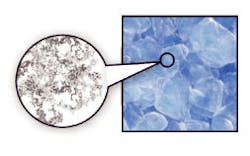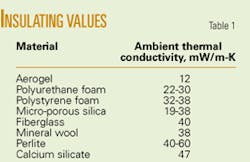Christopher E. Smith, Pipeline Editor
Progress in aerogel technology is advancing its use as subsea pipeline and LNG carrier tank insulation. Expensive and complex production methods had previously limited aerogel’s use to specialized industrial, aerospace, and construction applications.
Silica aerogels consist largely of air (~95% or more) trapped in 2-50 nanometer pores within an organic or silica lattice. This pore size is less than the mean free path of air and makes air molecules within any given particle more likely to collide with the silica lattice (and transfer energy to that lattice) than with another air particle, thereby limiting potential gas-phase conduction through the material (Fig. 1).
The long molecular chain of the material creates a similarly long conduction path for heat transfer, thereby limiting it, while adding opacifiers such as carbon black or titanium dioxide to the material can significantly reduce radiant heat transfer.1
The combination of these qualities provides sufficiently high insulating properties that lowering the annular pressure of a pipe-in-pipe system becomes unnecessary, even for high-performance systems.1
Current aerogels boast effective performance from -321° to 1,200° F., based on an ambient thermal conductivity on either side of 12 milliwatt/meter-kelvin. This compares to 22-30 mW/m-K thermal conductivity for polyurethane foam and 19-38 mW/m-K conductivity for microporous silica insulations. Table 1 provides a comparison of aerogel’s insulating values versus other materials.
Aerogels have a surface area of 400-1,000 sq m/g.
Aerogels’ original development as an electrical insulator for semi-conductors makes them a poor capacitor, with no cathodic protection-related issues added to pipeline maintenance. Being hydrophobic allows for exposure without degradation in the event of line repair. Their chemically inert nature means that they will not react if the inner pipe of a pipe-in-pipe system is breached.
Cost savings
Cabot Corp., Boston, and Aspen Aerogels, Inc., Northborough, Mass. are competing to expand the use of aerogels in oil and gas applications.
Both companies’ materials create potential cost savings by lowering the number of production platforms needed to develop marginal or remote fields and reducing the size of the outer pipe in pipe-in-pipe systems.
Savings stemming from a smaller outer pipe and smaller or absent centralizers go beyond steel costs and may well outweigh the increased pipe-in-pipe insulation material costs brought about by use of aerogels. In addition to labor savings stemming from the easier insulation application using aerogel, the smaller OD (and perhaps WT) of the outer pipe offers welding cost savings.
The drop in the pipe’s linear weight also yields potential savings by increasing the amount of pipe that can be placed on a given spool or vessel and expanding an operator’s options regarding what lay barge can be used for a given job.1
For example, using Cabot’s Nanogel expansion pack would allow an 11-in. outer pipe to surround an 8-in. flowline and obtain a conductivity of 0.7 W/sq m-K. The same conductivity would require a 14-in. outer pipe if polyurethane foam were used as the insulation. Similarly, the 25-km run that polyurethane foam could provide in an 8 × 12-in. pipe-in-pipe system could be increased by about 70%, to roughly 40 km, with a Nanogel expansion pack.2
These properties also allow aerogel’s effective use in high-pressure, high-temperature subsea pipeline applications and provide increased capacity or reduced boil-off in LNG transport and storage vessels.
Installation
Cabot launched its Nanogel line of aerogel insulation products at the Offshore Technology Conference in Houston, May 1, 2006.
Cabot manufactures its Nanogel particles in ambient conditions (vs. super-critical drying) in sizes from 8 μm to 3.5 mm and recommends a particle size distribution of 1-3 mm for oil and gas applications to optimize thermal performance and packing density.
The company emphasizes its Expansion Pack system as a way of packing the insulation into tight annular spaces such as those found in pipe-in-pipe systems. Two molded half-shells of the material surround the inner pipe, which is then inserted into the outer pipe. A subsequent breach of the vacuum maintaining the half shells’ form (with an inlaid heating wire) completely fills the annular space between the pipes, creating a mechanical bond that transfers both radial and axial loads between the inner and outer pipes (Fig. 2).
The resulting mechanical bond reduces the need for heat-bridging centralizers and allows for greater stability through pipelay and other mechanical loads.
Operators that wish to avoid or minimize the mechanical bonding associated with the expansion pack can use Cabot’s Compression Pack. Determining the size and U-value of the insulation layer prior to installation and activation (with a metal sheath that maintains compression) allows fully independent movement of the inner and outer pipes (Fig. 3). Unlike most insulations, aerogel’s performance often improves when compressed.
Cabot primarily sells its Nanogel aerogel into the construction and building markets. The company is engaged in ongoing qualification work with industry partners in the oil and gas market. Cabot also sees potential future applications on hot subsea equipment.
Blankets
Aspen isolates its aerogels into thin, flexible blankets infused with silica nanostructures and has created a variety of organic and inorganic-organic hybrid aerogel formulations (polydimethylsiloxane-silica, cellulose polyurethane, polyimide, polymethymethacrylate-silica, and polybutadiene rubber) that it says show enhanced physical and mechanical properties relative to pure silica aerogel.
It introduced three new aerogel blankets at OTC, two designed for cryogenic applications and one for continuous high-temperature use up 660° F. The cryogenic blankets measure 2 mm and 6 mm thick and, according to Aspen, can cut boil-off rates on LNG ships by as much as 40%.
The high-temperature blanket (also good for continuous use at temperatures as low as -150° F.) is already being installed on the high-pressure steam lines of a steam-assisted gravity drainage project in Canada’s Athabasca oil sands. Aspen points to the blanket’s speed of installation, low thermal conductivity, and smaller profile as logistical and cost advantages as compared to traditional materials.
Previous Aspen aerogel products have been pre-qualified for pipe-in-pipe reeling and offshore operation by Technip Offshore UK Ltd. and deployed in subsea pipe-in-pipe systems in both the Gulf of Mexico and offshore West Africa.
In LNG applications, Aspen says its Cryogels can meet condensation control requirements with a smaller radiative surface area, lowering total heat gain and subsequent boil-off by 20-30% (roughly 0.2-0.3% of the annual throughput of a typical import or export facility). Aspen also maintains that its cryogenic aerogels can increase capacity of LNG carriers by 5,000-11,500 cu m for a given hull size.
References
1. Denniel, Sylvain, and Blair, Chris, “Aerogel Insulation for Deepwater Reelable Pipe-in-Pipe,” Offshore Technology Conference, Houston, May 3-6, 2004.
2. “Technology Update: New Options, Improved Economics from Aerogel Insulation,” Society of Professional Engineers, JPT Online, June 2006.




